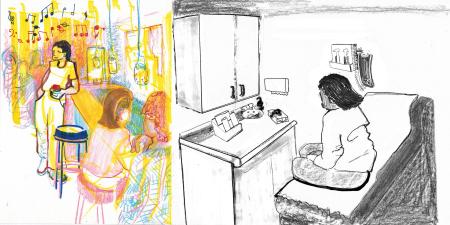Abstract
Iatrogenesis refers to harm experienced by patients resulting from medical care, whereas negligence is more narrowly conceived as deviation from standard care. While all harm resulting from negligence is iatrogenic, not all iatrogenic injury is negligent. This commentary on a case about a patient with a minoritized identity at the end of his life argues that criteria by which an iatrogenic injury is deemed negligent depend on how practice standards are defined.
Case
MJ is a 33-year-old transgender man who transitioned with hormone therapy during college. His parents immigrated from Mexico in their early 20s, settled in suburban Texas, and retain views about gender identity that MJ has, for many years, experienced as oppressive.
Recently diagnosed with advanced colorectal cancer, MJ has been hospitalized several times during the past year. His physicians recently conveyed to MJ that no curative options remain. MJ’s family members are distraught, blame MJ for bringing this upon himself and his family through his “lifestyle choices,” and insist that MJ denounce his gender identity. MJ expresses to Dr R, the hospitalist attending physician directing MJ’s inpatient hospice care, and Dr S, the resident physician, that he fears he will die alone, without anyone at his side, if he does not do as his family members ask.
Dr R reiterates the importance of family visits while MJ goes through the dying process and suggests that his gender identity, at this point in his life, should probably be regarded as less significant than his comfort and sense of family belonging. When alone with MJ, Dr S, who disagrees with Dr R, considers telling MJ, There is no need to compromise your identity. Be who you are to the end. We will be here with you, and you will not be alone when you die. Dr S considers whether to speak these words.
Commentary
Iatrogenesis refers to harm experienced by patients resulting from medical care, whereas negligence can be conceptualized more narrowly as “failure to use reasonable care, by … departures from accepted standards of care.”1 Therefore, while all harm that results from negligence is iatrogenic, not all iatrogenic injury is negligent. This essay argues that the criteria by which an iatrogenic injury is deemed negligent depend on accepted medical practice standards and what could be expected of a physician’s actions given the availability of guidelines and evidence, as well as accepted standards of care.
Determining Negligent Iatrogenic Harm
In 2019, the Council on Ethical and Judicial Affairs of the American Medical Association (AMA) released a report that highlights the failure of the AMA Code of Medical Ethics to examine clinical competence “as an ethical responsibility.”2 It asserts, quoting Epstein et al,3 that “the better part of the responsibility to maintain competence rests with physicians’ ‘individual capacity, as clinicians, to self-assess [their] strengths, deficiencies, and learning needs to maintain a level of competence commensurate with [their] clinical roles.’”2 This articulation of physician accountability echoes the rationale for continuing education required of physicians in the United States.
Scenarios in which patients are unable or not invited to freely communicate their needs could be viewed as both negligent and iatrogenic.
In this case of a patient with a minoritized identity, the determination of negligent iatrogenic harm rests on physicians’ ethical responsibility to identify, uphold, and apply standard of care. Care that expresses practice standards necessitates the same level of ongoing commitment to understanding needs of patients with minoritized identities as it does to continuing education on current therapeutic interventions. Failure to employ practices supported by contemporary standards of care for lesbian, gay, bisexual, transgender, and queer (LGBTQ) patients could thus be considered negligent in the same way that failure to implement contemporary standards for management of advanced colorectal cancer would constitute negligence and iatrogenic harm.
Affirming Communication for LGBTQ Patients
Although guidelines for care of patients with metastatic cancers have outpaced research on care for these conditions in LGBTQ patients,4 the medical field has recently undertaken guideline development for disease management and end-of-life (EOL) care for LGBTQ patients. The research on which the guide is based suggests that open-minded, affirming communication allowing for disclosure of history, identity, preferences, and goals is critical to delivering high-quality care that meets the needs of LGBTQ patients at the EOL.5 Scenarios whereby patients are unable or not invited to freely communicate their needs should be viewed as “effectively iatrogenic problems”6 because such communication does not meet standards of minimally acceptable—much less good—end-of-life care. Not employing affirming communication to effectively elicit LGBTQ patients’ life histories and values in shaping treatment goals could thus be considered negligent iatrogenesis.
In the case presented, both physicians presume to know what is best for MJ as they consider his imminent transition to hospice care at the end of his life. Dr R suggests that MJ’s identity ought not to be a more significant factor in his decision making than the ability of his family to be present at his bedside. Dr S intimates that preserving MJ’s identity could involve excluding his family from his dying process and that his identity should be the cornerstone of his decision making. Resolving this dilemma depends on preserving MJ’s autonomy to consider the values and actions that are most important to him. Respect for autonomy7 demands that a patient’s perspectives are weighed prominently in decisions. MJ’s gender identity and his experiences with his family might be relevant to the current decision point, contrary to what Dr R asserts. However, it is possible that, despite familial oppression, MJ might still value family presence at this moment of his life. Ascertaining what his preferences are and how he wishes to apply them now is more important than relying on either physician’s assumptions of what matters most. The physicians’ poor communication, which lead to their insufficient exploration of MJ’s framework for medical decision making, risks their imposing their views upon MJ’s dying process and incurring iatrogenic harm. At this critical moment, Drs R and S ought to prioritize open, collaborative communication with MJ to better understand his wishes and how he feels his family dynamics should shape familial involvement to ensure that his EOL care accords his wishes.
Relational Autonomy’s Importance
Decisions concerning familial involvement might be particularly complex in contexts wherein the centrality of patient autonomy is less established and other considerations, such as family harmony, might be more salient. The concept of relational autonomy, which acknowledges that individuals exist within complex networks of relations with others who shape their needs, values, and preferences, offers resolution to the seeming conflict between autonomy and relationality. Considering relational autonomy in approaching ethical dilemmas offers solutions that, in the words of Dove et al, “leave the ultimate decision to the person most affected, but encourage and facilitate the consideration of this person’s care and responsibility for connected others.”8
Palliative and hospice care, attuned to this concept of relational autonomy, centers the patient and their family as the locus of care.8 The delivery of this care can be complicated for patients whose identities are marginalized by their own biological family. Yet rather than viewing this marginalization as an impasse, it is crucial to understand LGBTQ patients’ preferences for involvement of family, biological or chosen, at the EOL—a further exercise of patient autonomy.
The earliest US-based publications on the experiences of LGBTQ patients receiving palliative therapies originated during the AIDS epidemic in the 1980s. These studies identified relevant barriers to care, including patients’ estrangement from their biological families as well as their desire to preserve chosen families’ role in medical decision making.9 This literature emphasizes the need for culturally responsive medical care that acknowledges the higher risks of decisional conflict for the dying patient and grief of disenfranchised members of the patient’s chosen family. A seminal report by the Institute of Medicine on providing high-quality care to LGBTQ patients supports this recommendation for culturally responsive communication in the care of LGBTQ patients across the life spectrum.10 Furthermore, a notable 2018 publication on best practices in caring for LGBTQ patients at the EOL emphasizes 2 especially pertinent points: (1) “that reconciliation with families of origin may or may not be welcomed or needed and should be discussed and pursued as per patients’ wishes” and (2) “that it is a patient’s legal right to include family of choice” in surrogate decision making or in the EOL process more generally.9
Given contemporary practice guidelines, determining iatrogenic harm must depend on whether a patient’s wishes for familial involvement are honored. Consideration of iatrogenic harm to a patient’s family is secondary to consideration of iatrogenic harm to a patient. If a patient does not want their biological family to be part of their dying process, the family’s absence is not a source of iatrogenic harm to the patient. But exclusion of chosen family from the patient’s dying process against the patient’s wishes should be considered negligent iatrogenic harm because it disregards the patient’s EOL wishes.
Centering Patients’ Perspectives
Distinguishing iatrogenesis from negligent iatrogenesis demands that we understand what could be done to prevent the harm and whether this action could be expected of physicians within a clinical setting. By employing affirming communication that focuses on eliciting the patient’s own values, perspectives, and wishes for their care and by attending to the unique psychosocial challenges and opportunities involved in caring for LGBTQ patients at the EOL, physicians can ensure compassionate, values-concordant care, thereby mitigating risk of negligent iatrogenic harm. Although it is unlikely that medical practice can entirely prevent iatrogenesis, it is through the continued commitment to learn, adapt, and take responsibility for understanding the multifaceted identities and values of patients that we can prevent negligent iatrogenic injury to patients and their loved ones during their most vulnerable periods of life.
References
- Klaas PB, Berge KH, Klaas KM, Klaas JP, Larson AN. When patients are harmed, but are not wronged: ethics, law, and history. Mayo Clin Proc. 2014;89(9):1279-1286.
-
Council on Ethical and Judicial Affairs. Competence, self-assessment and self-awareness. Report 1-I-19. American Medical Association; 2019. Accessed September 23, 2021. https://www.ama-assn.org/system/files/2019-12/i19-ceja-report-1.pdf
- Epstein RM, Siegel DJ, Silberman J. Self-monitoring in clinical practice: a challenge for medical educators. J Contin Educ Health Prof. 2008;28(1):5-13.
- Cloyes KG, Hull W, Davis A. Palliative and end-of-life care for lesbian, gay, bisexual, and transgender (LGBT) cancer patients and their caregivers. Semin Oncol Nurs. 2018;34(1):60-71.
-
Acquaviva K. LGBTQ-Inclusive Hospice and Palliative Care: A Practical Guide to Transforming Professional Practice. Harrington Park Press; 2017.
- Cloyes KG, Hull W, Davis A. Palliative and end-of-life care for lesbian, gay, bisexual, and transgender (LGBT) cancer patients and their caregivers. Semin Oncol Nurs. 2018;34(1):60-71.
-
Gómez-Vírseda C, de Maeseneer Y, Gastmans C. Relational autonomy in end-of-life care ethics: a contextualized approach to real-life complexities. BMC Med Ethics. 2020;21(1):50.
-
Dove ES, Kelly SE, Lucivero F, Machirori M, Dheensa S, Prainsack B. Beyond individualism: is there a place for relational autonomy in clinical practice and research? Clin Ethics. 2017;12(3):150-165.
- Maingi S, Bagabag AE, O’Mahony S. Current best practices for sexual and gender minorities in hospice and palliative care settings. J Pain Symptom Manage. 2018;55(5):1420-1427.
-
Institute of Medicine. The Health of Lesbian, Gay, Bisexual, and Transgender People: Building a Foundation for Better Understanding. National Academies Press; 2011.



